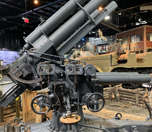The 8.8 cm Flak 36 is a German 88 mm anti-aircraft and anti-tank artillery gun, developed in the 1930s. It was widely used by Germany throughout World War II and is one of the most recognized German weapons of the conflict. Development of the original model led to a wide variety of guns.
The name applies to a series of related guns, the first one officially called the 8.8 cm Flak 18, the improved 8.8 cm Flak 36, and later the 8.8 cm Flak 37. Flak is a contraction of German Flugabwehrkanone (also referred to as Fliegerabwehrkanone) meaning “aircraft-defense cannon”, the original purpose of the weapon. In English, “flak” became a generic term for ground anti-aircraft fire. In informal use, the guns were universally known as the Acht-acht (“eight-eight”) by Germans and the “eighty-eight” by the Allies.
Air defense units were usually deployed with either a Kommandogerät (“command device”) fire control computer or a portable Würzburg radar, which were responsible for its high level of accuracy against aircraft.
The versatile carriage allowed the 8.8 cm Flak to be fired in a limited anti-tank mode when still on its wheels; it could be completely emplaced in only two and a half minutes. Its successful use as an improvised anti-tank gun led to the development of a tank gun based upon it: the 8.8 cm KwK 36, with the “KwK” abbreviation standing for Kampfwagen-Kanone (literally “battle vehicle cannon”, or “fighting vehicle cannon”), meant to be placed in a gun turret as the tank’s primary armament. This gun served as the main armament of the Tiger I heavy tank.
In addition to these Krupp designs, Rheinmetall later created a more powerful anti-aircraft gun, the 8.8 cm Flak 41, which was produced in relatively small numbers. Krupp responded with another prototype of the long-barreled 8.8 cm gun, which was further developed into the anti-tank and tank destroyer 8.8 cm PaK 43 gun used for the Elefant and Jagdpanther, and turret-mounted 8.8 cm KwK 43 heavy tank gun of the Tiger II.
After 1935, the anti-aircraft defense of Germany was controlled by the Luftwaffe. By the beginning of World War II the Luftwaffe’s anti-aircraft artillery employed 6,700 light (2 cm and 3.7 cm) and 2,628 heavy flak guns. Of the latter, a small number were 10.5 cm Flak 38s or 39s, the majority were 8.8 cm Flak 18s, 36s or 37s. This was twice as many heavy AA guns as RAF Fighter Command had at the time, with France and the United States having even fewer.
The guns were usually equipped with a Kommandogerät system, which was an analog gunnery computer. The Kommandogerät systems were introduced starting in 1925, and the Kommandogerät p40 was the standard system during the majority of the war. It allowed extremely precise fire and would even consider how far away the guns were from one another and the aiming crew, cancelling out the offset and aiming all weapons at the same point. This allowed multiple guns to be aimed precisely at the same target by a single command crew of five men, instead of requiring trained crews on each gun.
Radar aiming systems were also developed to complement these systems. The Würzburg radar series of radars was produced in the thousands and used widely. It allowed general area fire without line of sight, but had poor accuracy compared to the visual systems. This resulted in the Giant Würzburg, which had sufficient accuracy to precisely control guns without direct visual contact.







